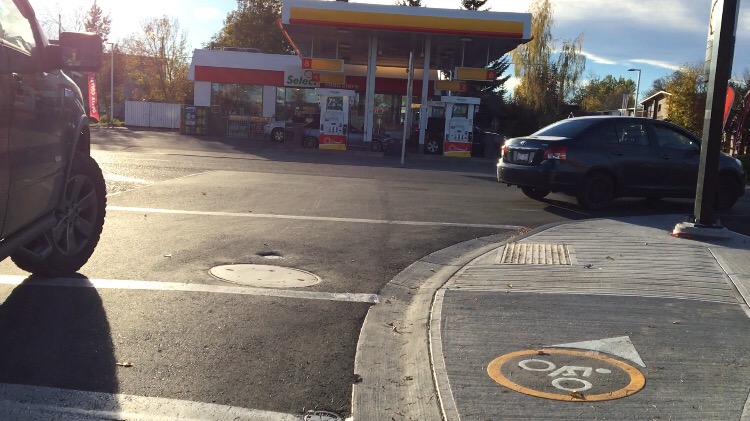A few weeks ago, I criticized cities for failing to build sensible connections between existing bike lanes.
Then I rolled over a relatively new piece of bike infrastructure in my city, and had a bit of a moment. “There,” I thought. “That wasn’t so hard, was it?”
Here’s that new piece of infrastructure.
https://www.instagram.com/p/BK2ClNDAamW/
(Just a little shout out to the dude in the video driving that black pickup truck who hogs the intersection and then accelerates needlessly fast — thanks for re-asserting your dominance of the roads in such a subtle way).
This may not look like much, but this intersection has some history. Back in 2011, the addition of a painted bike lane on one of the streets of this intersection prompted one of the city’s first bike boxes.
The problem was, it was a weird-ass bike box. It was oddly placed, few people understood how to use it, and fewer still actually used it. For several years, city workers gamely tried to “educate” people on proper use of the bike box, but even after watching the video and practicing, I was still a little baffled.
https://www.youtube.com/watch?v=8rqK2uwvnRA
Eventually, the city threw in the towel, and sent some poor road worker to scrape the green paint off the road.
Now, a few years later, a new bike lane on the intersecting road prompted another attempt. This time, a new tactic has been tried, whereby cyclists are directed from the street onto a short shared pathway before being returned to the road.
This thing isn’t perfect. It’s still a little odd, and putting cyclists onto what is basically the sidewalk is a little counter-intuitive, especially when there are a lot of pedestrians.

But if you take a broader look at this, there’s a lot to like. A few weeks ago, this was exactly the kind of missing connection I was ranting about. Now, it’s been fixed — a little creativity and a small amount of asphalt has filled this missing link.
That’s not the only one that has come together in recent weeks. Here’s another connection that has been a problem for years.
https://www.instagram.com/p/BK4MLVCAGII
These are the kinds of small investments that can make a huge difference in the daily transportation needs of cyclists. They are cheap fixes, done quickly, but these connections do much for improving the reliability of the bike network. This is the kind of thing that improves overall bike friendliness in a city. This is the kind of thing all cities should be doing more of.
Even more fundamentally, these are examples of a city giving things a shot. The first idea didn’t work, so something new is being tried. Even if this one flops like the last one, this is the kind of experimentation that leads to a better city.
Something like that is needed on 5st cycle track. Heading south and turning west onto another cycletrack is awkward because the bike box is so far to the left. A quick detour onto the sidewalk that brings one back onto the cycle track before the bike box would work better.
A few weeks ago I requested traffic light timing be changed at an intersection where cars cross 3 lanes and bicycles have to cross 6 lanes to the right shoulder. I recommend people call 311 and submit their suggestions.
My commute has a missing link as well. The work around is to take the sidewalk, cross the exit ramp onto the pedestrian island and make a left turn against traffic to turn around facing the correct way in the right lane to trigger the lights. If traffic is in the right lane I wait for them go through and merge in behind them.
An even better solution would be a bike sensor on the pedestrian island so cyclists can remain there until lights change.
Watching that video of the bike box on 5th Ave. NW with the complicated procedure was funny. “Wait for a gap in traffic, then turn left.” Yeah right. It takes awhile for planners to “get it” but they eventually do.
This “new” approach is good. It’s not really an experiment though. There are a few examples of this in Vancouver that have been around a few years. They work well. When you have two different street grids that meet but don’t line up, it’s the only way really without completely redesigning the entire intersection.
Great Northern Way and Brunswick.
https://goo.gl/maps/t9NoqTMPuTE2
Yukon and 16th Ave.
https://goo.gl/maps/Rj1rz2xa9Pt
Thanks for the context Clark. Glad to see cities learning from each other. Too often, planners feel like they need to reinvent.
Hi Tom,
I ride this route every day and unfortunately I can’t say it’s a good solution. It’s a little dangerous because you’re mingling pedestrians and cyclists in close quarters and it’s not clear who should be going where. I’ve already seen several close calls over the past few weeks and I would not be surprised if someone eventually gets injured here . Don’t get me wrong, I’m a huge fan of building more cycling infrastructure but it cyclists and pedestrians generally don’t mix.
Brad
I don’t disagree with you. There is bound to be conflict here eventually, but I think shared spaces are worth a shot. I’ve seen shared space work very well in other contexts, so I’m reserving judgement on this one for a little while. But I take your point. Thanks for sharing.
As a Calgarian presently cycling in Berlin, Germany, where there are plenty of bike lanes, the mingling of pedestrians and bikes is omnipresent and I suspect inevitable: in my observation, not problematic as long as cyclists are willing to slow down and cede right-of-way, or at least adequate time for each camp to recognize what the other is doing. Ja, it slows the average velocity, but this is a First World problem.
KZ